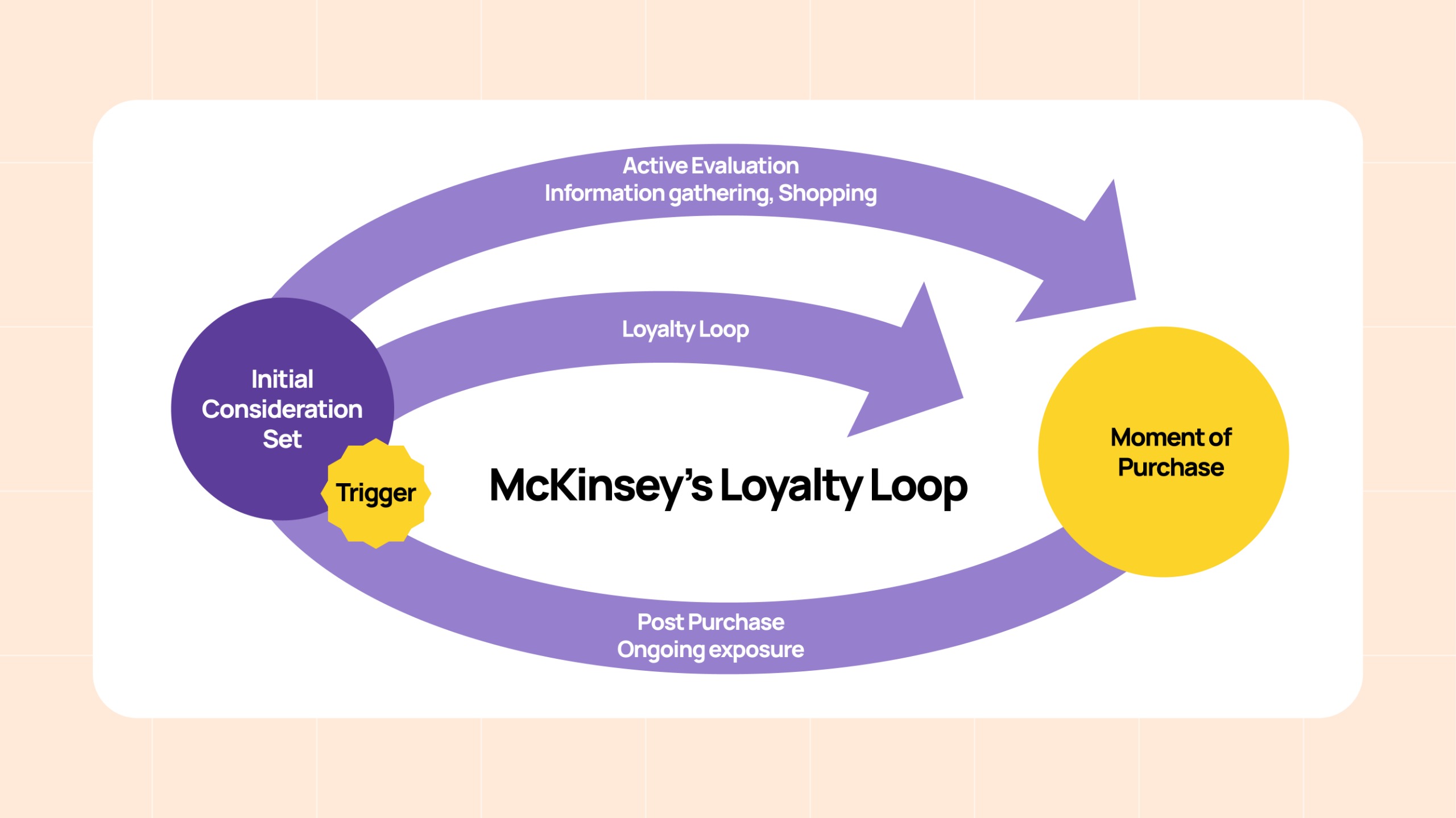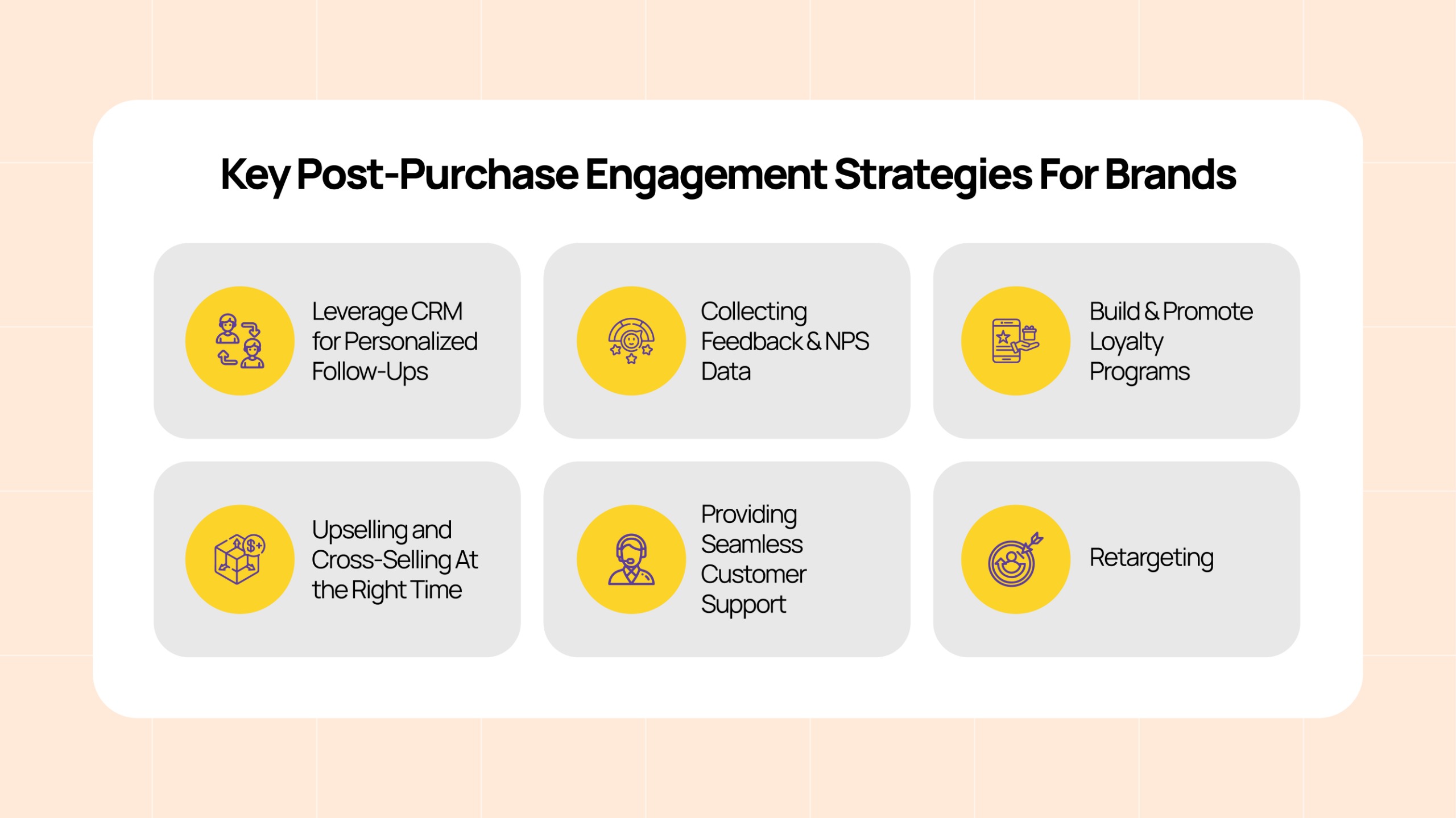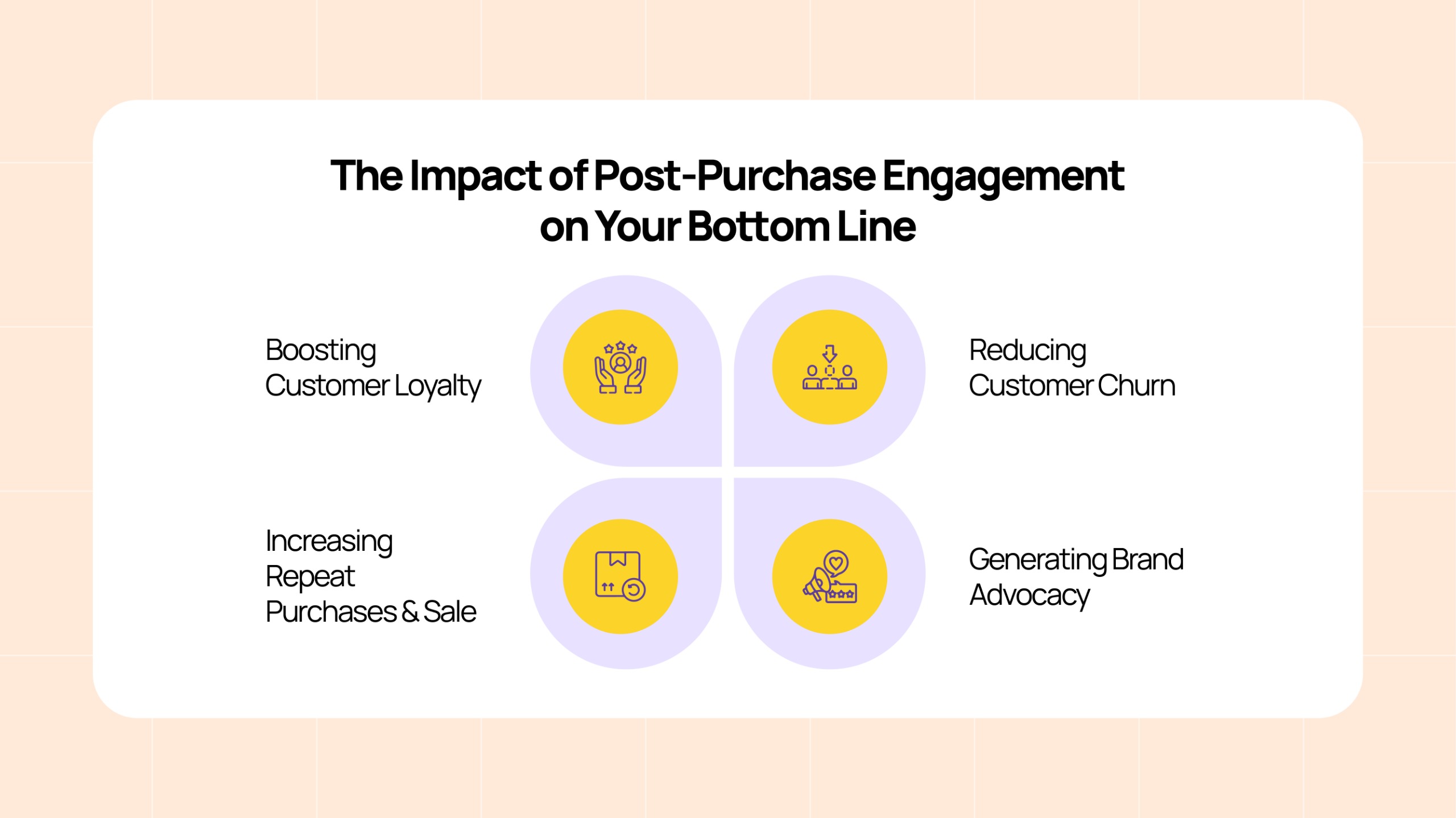
Did you know that 65% of a company’s revenue comes from repeat purchases of existing customers? (CX Today)
It has long been established that customer acquisition is costly, and it is customer retention that drives sustainable growth, but what is the key to turning first-time buyers into lifelong customers? The answer lies in the post-purchase window. It is a crucial phase that highlights that customer purchase is not the end of the journey; instead, it is a perfect opportunity to nurture loyalty, increase repeat purchases, and even convert them into brand advocates.
But are you capitalizing on this opportunity?
The post-purchase experience is a satisfaction peak, when customers are the most likely to feel good about their purchase. And when their satisfaction is at its highest, they’re primed for continued engagement. Most brands miss this opportunity by failing to engage customers during this phase, resulting in lost potential for loyalty and growth.
In this blog, we’ll explore the post-purchase window, how it aligns with McKinsey’s Loyalty Loop, and why engaging customers during their satisfaction peak is critical to CRM success.
The Origin of Post-Purchase Window with McKinsey’s Loyalty Loop
The post-purchase window starts immediately after a customer makes a purchase. The concept of the post-purchase window has evolved through insights from McKinsey & Company’s Loyalty Loop. It is a framework that redefines the traditional customer journey. Unlike the linear funnel model, where customers move from awareness to purchase, McKinsey’s Loyalty Loop suggests that the journey is cyclical. That is, once a customer makes a purchase, their post-purchase experience directly influences whether they will continue buying from your brand or drop off entirely.
What is McKinsey’s Loyalty Loop?

McKinsey’s Loyalty Loop model highlights the stages that occur after the initial purchase:
- Post-Purchase Evaluation: This is the moment a customer experiences the product. It is crucial because it can trigger positive or negative emotions that directly influence future behaviors.
- Repurchase or Advocacy: Satisfied customers enter a loyalty loop, making repeat purchases or promoting the brand to others, thereby creating a cycle that brings them back into the fold.
Through their research, McKinsey & Company identified that 60-70% of a brand’s revenue typically comes from repeat customers, making the post-purchase phase one of the most important opportunities to drive customer loyalty and repeat business.
Why Does the Post-Purchase Window Matter?
The post-purchase window is an often-overlooked phase in the customer journey, yet it holds incredible potential for driving long-term business growth. While businesses invest heavily in acquiring new customers, many fail to capitalize on the opportunity to engage with their existing customers after a purchase is made. This missed opportunity could be costing businesses much more than they realize.
Statistical Insight
According to Harvard Business Review, it costs 5 to 25 times more to acquire a new customer than to retain an existing one. This stark difference underscores the importance of investing in customer retention strategies. This is because retained customers not only provide a higher return on investment (ROI), but they also tend to spend more over time. Research shows that repeat customers spend up to 67% more than first-time buyers.
The Power of Customer Emotions in Post-Purchase
Customer satisfaction doesn’t stop at the checkout counter. In fact, customer emotions during the post-purchase window play a huge role in determining whether they will return. Right after making a purchase, a customer is at their satisfaction peak, and how you engage with them in this moment can determine whether they become a loyal advocate or move on to a competitor.
HubSpot studies show that 93% of customers are more likely to make repeat purchases from a brand that provides excellent customer service post-purchase. This is where businesses can create strong emotional connections with their customers. When customers are happy with their purchase, they feel validated, and that positive feeling can fuel a deeper emotional connection with your brand. The emotional component of customer loyalty is powerful, as 65% of customers find a positive experience to be more influential in their shopping experience (PwC).
However, the post-purchase window is not just about avoiding dissatisfaction. It’s about actively reinforcing the positive emotions that customers feel after they’ve made a purchase. Brands that connect with customers during this time can significantly increase customer retention.
Key Post-Purchase Engagement Strategies For Brands
As already mentioned, the post-purchase window is an important phase where brands can build customer loyalty and drive repeat purchases. Here’s how brands can capitalize on this phase with effective CRM strategies that ensure customers stay engaged long after their initial purchase.

- Leverage CRM for Personalized Follow-Ups
One of the most impactful ways to engage customers post-purchase is through personalized communication. CRM tools can help you automatically send personalized emails or messages thanking customers for their purchase, providing tips on product use, or offering recommendations based on their buying behavior. Personalization increases customer satisfaction, and 52% of consumers are more likely to shop with brands that personalize their experiences (Segment).
CRM Application: Use your CRM’s automation capabilities to send timely, personalized emails or SMS with tailored offers, loyalty points, or product suggestions based on their previous purchases.
- Collecting Feedback & NPS Data
Post-purchase surveys and NPS (Net Promoter Score) are powerful CRM tools to capture customer satisfaction and identify areas for improvement. Actively asking for feedback immediately after a purchase helps you assess product performance, customer sentiment, and identify potential pain points. Happy customers are likely to leave positive reviews, while dissatisfied customers can be addressed before they churn.
CRM Application: Automate NPS surveys or feedback requests within your CRM platform and use the data to segment customers for personalized follow-ups, offers, or customer support.
- Build & Promote Loyalty Programs
Loyalty programs are a great way to incentivize repeat purchases and keep customers engaged post-purchase. A strong loyalty program can send customers rewards updates, exclusive offers, or early access to sales based on their purchase history. This ongoing engagement can keep them coming back and boost customer lifetime value (CLV).
CRM Application: Use CRM data to automate loyalty points, send reminder emails for rewards, and create personalized offers that are linked to a customer’s previous spending behavior.
- Upselling and Cross-Selling At the Right Time
The post-purchase window is also a prime time for upselling and cross-selling. When customers are satisfied with their purchase, they are more likely to consider complementary products. With CRM data, you can easily recommend products that align with the customer’s preferences or purchase history, creating a more personalized shopping experience and increasing average order value (AOV).
CRM Application: Implement automated cross-sell and upsell recommendations based on customer purchase history, using CRM analytics to understand what products to recommend.
- Providing Seamless Customer Support
Post-purchase engagement is about providing excellent after-sales service. Having a 24/7 helpdesk, chatbots, or easy access to support ensures that customers feel cared for throughout their journey.
CRM Application: Use your CRM system to track customer service interactions and automatically follow up with customers after an inquiry or issue has been resolved.
- Retargeting
Retargeting customers who made a purchase with personalized ads can remind them of the brand experience and keep them engaged. With CRM-integrated marketing tools, brands can segment customers based on their purchase history and create personalized ad campaigns that bring them back to make another purchase.
CRM Application: Use your CRM to segment customers on the basis of their past interactions and purchases and retarget them with personalized ads.
Why CRM Strategies Matter For Post-Purchase Engagement?
Effective CRM strategies allow businesses to engage customers at every touchpoint, even after purchase. By leveraging CRM tools like segmentation, personalization, and automation, brands can optimize the post-purchase window to not only retain customers but convert them into brand advocates. When your CRM system is fully integrated into your customer journey, businesses can make sure that their engagement efforts are effectively timed, personalized, and impactful, leading to higher customer lifetime value (CLV) and increased loyalty.
Challenges in the Post-Purchase Window: Why Most Brands Miss A Mark?
The post-purchase window is a great time to nurture customer loyalty and drive repeat business. Despite its significance, many brands miss the mark during this critical phase. The reasons are often rooted in outdated processes or a failure to fully understand the value of customer engagement beyond the transaction.

Here are some of the key challenges brands face when it comes to post-purchase engagement:
- Lack of Automation
One of the most common pitfalls in post-purchase engagement is the lack of automated systems to trigger timely follow-ups. Without automation, brands risk letting their customers fall into the void after the initial purchase. Manual follow-ups can be delayed, inconsistent, or entirely missed, leaving customers feeling unimportant.
Why it matters: Timing is everything in post-purchase engagement. Without automation, brands miss the critical window to connect with customers while their satisfaction is still fresh. Automated tools such as email sequences, SMS reminders, and loyalty program sign-ups can help ensure that every customer receives timely and personalized communication.
Example: Amazon excels in this area. After a customer makes a purchase, the brand automatically sends a confirmation email, followed by delivery updates, product recommendations, and review requests. This automated flow keeps customers engaged and satisfied with the process, while also ensuring that they continue interacting with the brand.
- Ignoring Feedback
Another significant challenge is ignoring post-purchase feedback. When customers are not asked about their purchase experience, brands miss valuable insights that could help improve their products, services, and overall customer experience. Collecting Net Promoter Score (NPS) feedback, customer satisfaction surveys, and product reviews is essential to gauge how well the customer journey is going beyond the transaction.
Why it matters: Post-purchase feedback is an opportunity to either reinforce a customer’s positive experience or address dissatisfaction before it leads to churn. According to Oracle reports, 86% of customers would pay more for a better customer experience. Gathering feedback also provides brands with actionable insights to refine their products or services, ensuring that the next customer’s experience is even better.
Example: Zappos is an industry leader in collecting feedback. They proactively reach out to customers post-purchase to ensure satisfaction and resolve any issues. This consistent feedback loop contributes to their reputation for exceptional customer service and loyalty.
- Overlooking Post-Sale Communication
Many brands make the mistake of considering the customer journey complete once a sale is made. This leads to overlooking post-sale communication, which results in customers disengaging from the brand. After the purchase, customers are still actively looking for ways to engage with the brand, whether through follow-up information, product support, or loyalty rewards. Without post-sale communication, customers are left to move on without further brand interaction.
Why it matters: Engagement after the sale creates a sense of value and connection. Brands that fail to engage during this phase miss out on the chance to turn a one-time buyer into a repeat customer. Post-sale communication can include order tracking updates, thank-you notes, loyalty program invitations, and upsell/cross-sell opportunities. These communications reinforce the brand’s value and keep customers within the brand’s ecosystem.
Example: Starbucks is well-known for its post-purchase communication. After customers make a purchase, they receive personalized offers through their Starbucks Rewards program, keeping them engaged and coming back. By offering rewards, exclusive promotions, and relevant updates, Starbucks fosters an ongoing relationship with customers that extends well beyond the point of purchase.
The Impact of Post-Purchase Engagement on Your Bottom Line
Post-purchase engagement can directly influence your bottom line. Engaging customers after they make a purchase helps foster loyalty, drive repeat business, and create brand advocates, all of which are key to sustained growth.

- Boosting Customer Loyalty
When businesses engage with customers post-purchase, they create the conditions for longer relationships and greater overall spend. According to Invesp, repeat customers spend 67% more than first-time buyers.
- Reducing Customer Churn
Post-purchase engagement helps to reduce churn by keeping customers happy and feeling valued. Engaged customers are less likely to abandon a brand, leading to higher retention rates and a more predictable revenue stream.
- Increasing Repeat Purchases & Sales
The post-purchase window is an opportunity to remind customers of their satisfaction and encourage them to make a second or third purchase. Customer engagement strategies help reinforce the emotional connection between the customer and the brand.
- Generating Brand Advocacy
Happy customers not only come back, but they also tell others about their positive experience, expanding your customer base without additional marketing costs. When brands engage post-purchase, they create brand advocates who willingly spread the word, effectively becoming free advertisers for your business.
Conclusion
The post-purchase window represents one of the most underutilized opportunities for brands to drive loyalty, growth, and customer satisfaction. During this time, you can nurture relationships, influence repeat behavior, and convert satisfied customers into passionate advocates. The McKinsey Loyalty Loop teaches us that once customers are happy, they’re not only likely to return, but they’re also primed to promote your brand to others.
So, are you capitalizing on the post-purchase window? Because the opportunity to create long-lasting, profitable relationships begins right after the purchase, and with the right strategies, you can ensure that your customers keep coming back, not just for one purchase, but for many.